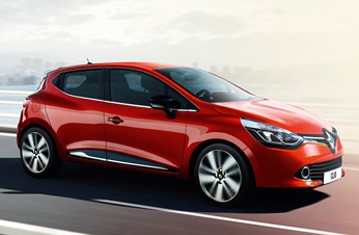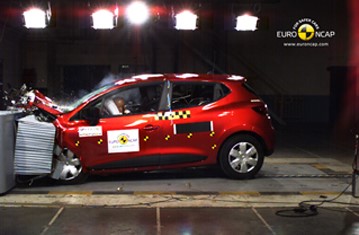Find more information in the General Comments section of the assessment
Find more information in the Rating Validity tab of the assessment
- See More
- See More
- See More
- See More
- Good
- Adequate
- Marginal
- Weak
- Poor
 Passenger
Passenger
 Driver
Driver
 Front Seat
Front Seat
 Car
Car
 Pole
Pole
- Good
- Adequate
- Marginal
- Weak
- Poor


Passenger
outboard
center
Fitted to the vehicle as standard
Not fitted to the test vehicle but available as option
Not Available
The Clio scored maximum points for the protection provided to the 18 month dummy in the dynamic impact tests. Forward movement of the 3 year dummy, sat in a forward-facing restraint, was not excessive. In the side impact, both dummies were properly contained by their restraints, minimising the risk of the head contacting parts of the car interior. The passenger airbag can be disabled to allow a rearward-facing restraint to be used in that seating position. Clear information is provided to the driver regarding the status of the airbag and the system was rewarded by Euro NCAP. The dangers of using a rearward-facing child seat in that position without first disabling the airbag are clearly explained in the vehicle. From VIN VF15R5A0H50930591 (May 2014), cars no longer have ISOFIX or top tether anchorages on the front passenger seat. This would decrease the score for child occupant protection to 87 percent but the vehicle would still qualify for a 2012 five star rating.
- Good
- Adequate
- Marginal
- Weak
- Poor

Head Impact 11.8 Pts
Pelvis Impact 5.9 Pts
Leg Impact 6.0 Pts
The bumper provided good protection to pedestrians' legs and scored maximum points. Protection offered by the front edge of the bonnet was predominantly good. In most of the areas likely to be struck by a child's head, protection was poor or marginal. Similarly, marginal or poor protection was provided by the bonnet in those areas likely to be struck by an adult's head.
- Good
- Adequate
- Marginal
- Weak
- Poor
| System Name | ESP | |
| Performance | ||
| Vehicle Yaw Rate @ COS + 1.00 s | 2.67% | meets ECE requirements |
| Vehicle Yaw Rate @ COS + 1.75 s | 2.61% | meets ECE requirements |
| Lateral Displacement @ BOS + 1.07 s | 2.98 m | meets ECE requirements |
| Applies To | All seats | ||
| Warning | Driver Seat | Front Passenger(s) | Rear Passenger(s) |
| Visual | |||
| Audible | |||
|
|||
Electronic stability control is standard equipment on all Clios and the system met Euro NCAP's test requirements. A seatbelt reminder system is standard for the front and rear seats and a driver-set speed limitation device is also fitted to all Clios.
- Specifications
- Safety Equipment
- Videos
- Rating Validity
Specifications
Tested Model Renault Clio 1.0 base grade, LHD
Body Type - 5 door hatchback
Year Of Publication 2012
Kerb Weight 1087kg
VIN From Which Rating Applies Click here to access the list.
Class City and Supermini
Safety Equipment
Note: Other equipment may be available on the vehicle but was not considered in the test year.
Fitted to the vehicle as standard
Fitted to the vehicle as option
Not fitted to the test vehicle but available as option
Not Available
Not Applicable
Videos
Rating Validity






Find more information in the General Comments section of the assessment
 Share
Share










The passenger compartment of the Clio remained stable in the frontal test. Dummy readings indicated good protection of the knees and femurs of both front seat occupants. Renault showed that a similar level of protection would be provided to occupants of different sizes and to those sat in different positions. In the side barrier test, the car scored maximum points, with good protection being offered to all body regions. However, in the more severe side pole test, dummy readings of rib compressions indicated weak protection for that body region. The seat and head restraint provided marginal protection against whiplash injury in the event of a rear-end collision.